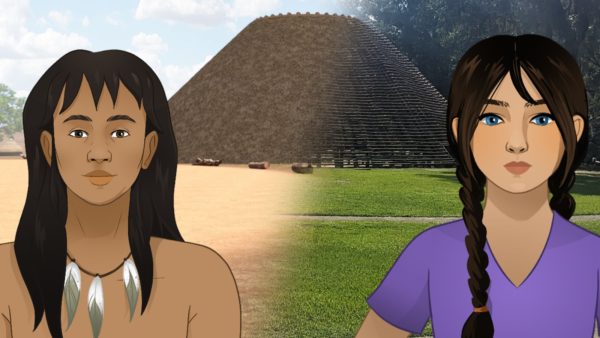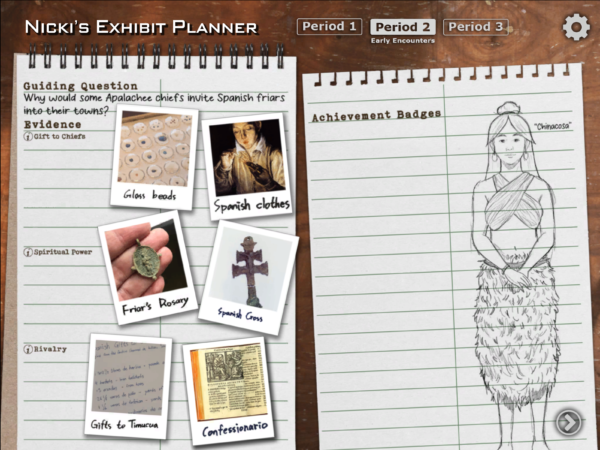5 Reasons to Start Your School Year with “Spirit of a Nation”
As we usher in a new school year, we’re delighted to share this guest blog by veteran social studies teacher Paul Frankmann!
The educational gaming series Mission US has been a core part of the 8th Grade Social Studies curriculum at Harmon Middle School in Aurora, Ohio, for years. Their newest mission, Spirit of a Nation, is an interactive case study that lays the groundwork for an exciting year in Social Studies, whether the class is a World History course or an American History course. I believe it would be a great experience to give students for five key reasons:
1. “Spirit of a Nation” bridges the gap between the World History and U.S. History Social Studies curriculums – and supports state Social Studies standards for both!
In Ohio, 7th Grade Social Studies explores World History from 750 BC through 1600 AD, finishing with a study of the Spanish Explorers and Conquistadors. 8th Grade U.S. History begins with the Jamestown and Plymouth colonies, and includes first encounters between native peoples and English settlers. “Spirit of a Nation” offers an ideal bridge between the two courses as a case study of first encounters between native Apalachee people in what is now Florida, and Spaniards arriving in the 1600s. While not all states may have this same sequence of instruction, this case study of the Apalachee provides context for studying the Powhatan, the Pequot, the Iroquois, the Shawnee, the Cherokee… or any other Native American nation in any part of what becomes the United States, no matter when it’s covered in your curriculum.
“Spirit of a Nation” also directly supports state and national Social Studies standards and covers all four Social Studies strands: History, Geography, Government, and Economics.

2. Like all Mission US games, “Spirit of a Nation” helps to personalize history.
“Spirit of a Nation” tells the story of 15-year-old Nicki Seward, a descendant of the Apalachee people working as an intern at the Mission San Luis historical site in Florida. Archaeologists coach her to examine artifacts from the Apalachee culture – her culture – and to make inferences about their purposes and meaning, ultimately leading to a process of “historically imagining.” Nicki and players imagine themselves in the role of a different Apalachee teen at three key points – in Part 1, before Spanish contact; in Part 2, just as Spanish missionaries are starting to interact with the Apalachees; and in Part 3, later in the 1600s, when players have developed more complex relationships with and a range of different opinions about the Spanish. At the end of each part, Nicki and players create pop-up exhibits inspired by achievements earned in the mission. Seeing Nicki take pride in learning about her own history and culture can inspire students to seek connections to their own heritage, perhaps through a walkabout of their hometown community as we’ve done with our 8th graders in Aurora.
3. “Spirit of a Nation” engages students in considering multiple perspectives, which is important for gaining an honest understanding of any historical event.
It isn’t a generalized Apalachee or Spanish perspective that students encounter, but individualized perspectives representing different persons, villages, and roles. For example, in Part 3, Nicki, as Apalachee teen Juan Chuba, interacts with a Spanish missionary who has been kind to Juan’s family, an Apalachee cousin who has determined to resist the Spanish, an Apalachee farming family that has been cheated by the Spanish, Spanish sailors and soldiers, and rival Timucua natives there to trade. Imagining themselves in different roles and considering different perspectives is key to understanding the choices made by every individual and group in the game. The Apalachee and Spaniards will each borrow from each other those things that will bring them advantage. Cultural diffusion will go both ways. This is a constant process that weaves throughout American History – leading into the Revolution and beyond – as European, Native American, and African cultures interact and become intertwined and somewhat interdependent. Thus, beginning the year with “Spirit of a Nation” will give students even more of a toolkit of skills needed to better understand the “Spirit of 1776” in all its complexity.
4. “Spirit of a Nation” requires students to make, reflect on, and face the consequences of their choices throughout the game.
Different game choices lead students down different realistic pathways with different consequences. There are no “right” answers to a given situation, but better information that builds upon experience may lead to better outcomes.
The Spirit of a Nation educator guide includes Mission Reflection activities and “Decision Trackers” to help students examine these choices more deeply. For example, in Part 3, students are asked to pick one of four ambitions for their role as Juan Chuba, and make complicated decisions about how to travel to port to complete his errands, which goods to trade and who to trade with as well as who to trade for, before finally deciding whether to tie their future with the Spanish missionaries, Apalachee farming families, or Apalachee rebels. The Decision Tracker asks them to consider what personal experiences influenced their decisions, and what dilemmas followed from the expanding influence of Spanish rule over time.
This understanding of choices and chains of consequences also helps students to better examine later historical events – such as how the Constitution was built of compromises – and to draw personally meaningful lessons from their study of history that can be applied to understanding their present.
5. “Spirit of a Nation” models “thinking like a historian.”
Historians ask questions, and then work like detectives to find and sort through the available evidence in order to suggest possible answers. When new or different evidence is considered, old conclusions are often reconsidered, and new questions follow naturally. The most interesting questions aren’t DOK (Depth of Knowledge) level 1 who, what, where, and when questions, but DOK level 2 and higher order thinking why and how questions.

Not only do students ask and answer questions in character with all kinds of people throughout the game, they also work to answer questions for their pop-up exhibits over the course of Spirit of a Nation. Students collect, categorize, and analyze evidence during each part of the game, which becomes a part of the planning for their exhibits. The Teacher’s Guide offers, as an extension, Document Analysis activities. For example, a Part 3 activity has students examine one of two artifacts encountered during the game, note what they see, think and wonder about it, and consider what it might show about Apalachee culture, Spanish culture, or the intersection of the two.
Questioning shows thinking and kindles curiosity, and is the most important habit that Social Studies classes can encourage students to practice. This habit brings any activity in any topic in any unit to life for students because it personalizes the content.
“Spirit of a Nation” models the skills that students will use and build upon throughout their year in an engaging, exciting, and validating way and inspires students to be curious, and to ask questions from day one. I can’t think of a better way to start off any Social Studies course.

Paul Frankmann is a recently retired Social Studies and French teacher as well as Wrestling and Soccer coach with 38 years in the classroom. He taught 8th grade American History and French I at Harmon Middle School, in Aurora, Ohio, where he used several of the Mission US games as a core part of his 8th grade history curriculum. Paul has Bachelor’s Degrees in International Studies and French and an MAT in Secondary Education from Miami University of Ohio, as well as an MA in American History from Gilder Lehrman/Pace University. Beyond the classroom he has worked in education developing curriculum with the American Red Cross and the Cuyahoga Valley National Park. Paul lives in Aurora with his wife Angi, who teaches 8th grade Science at Harmon, along with their dog Ozzy and their Green Cheeked Conure Turq. They have two grown children, Justin and Emma, and are expecting their first grandchild this fall.